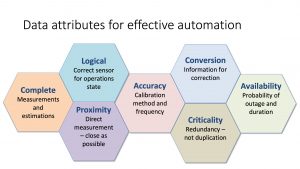Instrument Measurement Systems
Systems of Interest Mapped with IMS examples across the DSA Architecture. A COMPREHENSIVE view of sensors and data across drilling developed by the DSA Roadmap IMS team.
A detailed description of IMS performance targets is available in the DSA Roadmap section.
Sensor Attributes

Sensors, Instrumentation and Measurement Systems for Drilling Systems Automation should meet certain rules to ensure users understand how a measurement, or a set of measurements, will affect the process being automated.
| Rule | Description | |
| 1 | Completeness | There must be enough information to fully determine the state of the system. |
| 2 | Logic Determination | There must be all information necessary to choose the correct sensor as a function of the system state. |
| 3 | Proximity | Sensors shall measure as directly and as closely as possible to the required parameters. The four types of proximity include:
a) Direct: measured directly at the desired location. b) Transposed: converted from some measurement conditions to another. c) Derived: depends on at least two consecutive measurements. d) Estimated: depends on a series of measurements and initial conditions. |
| 4 | Accuracy | There must be enough information to assess the accuracy of the measurement. If a measurement is made remote to the desired location, there must be sufficient information to access the accuracy of the estimated measurement. |
| 5 | Conversion | There must be enough information to correct the measurement. If this is physically not possible, a new sensor will be envisioned to solve the error. |
| 6 | Criticality | There must be measurement redundancy for critical parameters, which means there must be different measurement paths for critical parameters and not just different sensors at the same point. |
| 7 | Availability | The availability of each sensor must meet or exceed the requirement of the most demanding application for which it is used. Availability performance is a statistical specification which is defined as the probability of sensor outage vs. outage duration. Applications are classified into 1 of 4 groups based on availability requirement. These groups, from the most to least demanding are:
a) Closed-Loop Control: No humans in the control loop. a. Fast-Loops: Latency < 1 sec b. Slow-Loops: Latency > 1 sec b) Supervisory Control: Human in the control loop. c) Diagnostics: Applications delivering visual information for a human. d) Archival: Applications that store data for historical reference. |



